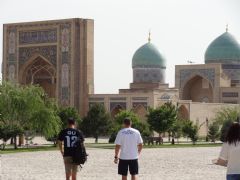In my absence, the team had managed another couple of good results & so we are now really beginning to impose ourselves at the top of the table. A victory on Tuesday was then followed two nights later by an away game on the outskirts of Bangkok against BEC Tero Sasana. It just goes to show that the Thai FA have little interest in supporting their teams that are competing in the AFC Champions League. We were not surprisingly a little tired & managed a 1-1 draw before heading to the airport to fly out to Tashkent for our AFC Champions League game against Bunyodkor on Tuesday.
Tashkent is the capital of Uzbekistan & a surprisingly beautiful place. The old city is renowned for having some of the finest examples of Islamic artisan architecture in the world & the domes along with the mosiac clad archways are extremely impressive.
Whilst I am here, I am managing to read up on posterior ankle impingement syndrome. One of our players has been struggling with symptoms for about 5 months now & after quizzing the team's medical staff, there doesn't seem to have been much done in the way of further investigations or establishing a differential diagnosis. Subsequently, I am taking the lead despite only being recently made aware of the case.
In my opinion, the clinical history is critical & there are several key points that I was able to glean with the aid of our translator regarding previous traumatic injury & patchy ongoing management strategies. As a result, the possible causes of the impingement may include one or more of: scar tissue, a chondral defect or an ATFL rupture. I also want to get a comprehensive battery of weight-bearing x-rays organised to rule out the presence of any syndesmosis damage, demonstrated by a change in the position of the tibia & fibular in relation to the talus. Ruling out the presence of an os trigonum will also be important & the research suggests that this is best achieved with MRI.
The following are links to abstracts & published articles for some of the papers that have been helping guide the clinical management of the player concerned & I hope they are of benefit to you:
Niek van Dijk, C. (2006). Anterior & posterior ankle impingement. Foot Ankle Clin; 11(3): pp 663-683
In the meantime, it's time for me to get back to conducting our travel recovery strategies to ensure our players are in the best possible condition to take on the Uzbeks on Tuesday!!!

